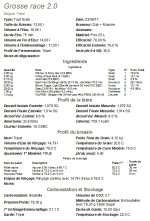Hello,
I've made a recipe of Belgian Tripel on Beersmith :

With a two-steps mashing :

And I get an OG of 1.079, FG of 1.014 and 8.6 % abv :

Everything ok so far.
But when I change the temperature of the 2nd step from 72 deg C to 73 deg C, the abv reaches 10.4 %.
The OG doesn't change but the FG drops to 1.001.


I can't understand this. I think there's some kind of bug here ?
Thanks
I've made a recipe of Belgian Tripel on Beersmith :

With a two-steps mashing :

And I get an OG of 1.079, FG of 1.014 and 8.6 % abv :

Everything ok so far.
But when I change the temperature of the 2nd step from 72 deg C to 73 deg C, the abv reaches 10.4 %.
The OG doesn't change but the FG drops to 1.001.


I can't understand this. I think there's some kind of bug here ?
Thanks

